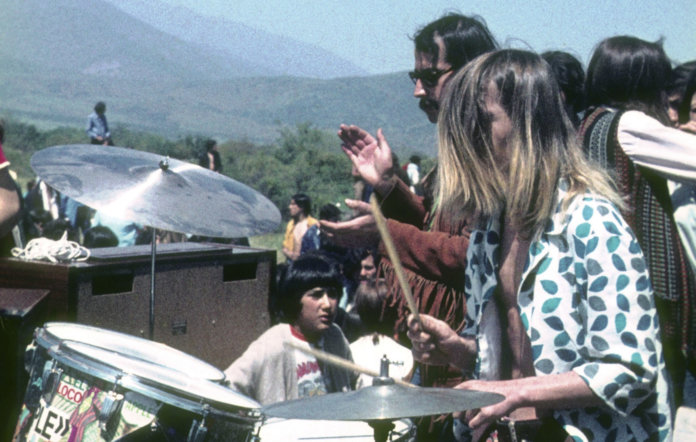The “Woodstock Generation” was not confined just to North America and Europe. Across the world, counter-cultural ripples amongst the young caused ructions in societies normally bound by strict traditional ways. After the Woodstock film was screened in Chile, 19-year-old student Jorge Gomez was inspired to put on a free festival, Piedra Roja, which would become an emblematic moment in the life of the nation. Taking place on a stretch of land in the hills outside eastern Santiago between the October 10 and 12, 1970, it seemed to presage the election the following month of Salvador Allende as President. “We had an intuition that the world could be different,” says actress/playwright Malucha Pinto, who attended the festival. “A world in which liberty, solidarity, community, understanding and justice existed.” Through copious interviews with participants and scraps of period footage, this fascinating documentary paints a picture not just of the festival but of the social conditions which spawned it, and the repercussions which followed.
In the late ‘60s, the Chilean music scene was on the cusp of change. Bands like Los Ripios, Trapos and Blops were beginning to explore the boundaries between pop, traditional Chilean music and more exploratory modes, producing a sort of local variant of Tropicalismo with flute-based folk-rock and harmonies. Los Jaivas ditched their bowties and gold-buttoned blazers in favour of a more freewheeling look, and changed their sound accordingly: within months, they had produced their first “symphonic” work, a Zappa-esque piece “based on sonic distortion”. And inspired by Lennon & Ono’s Two Virgins, the band Aguaturbia decided that they, too, would appear naked on their album sleeve. It was a sensation, instantly outselling every album in Chilean history. “We were young, naive, talented and marginalized,” laughs singer Denise Aguaturbia today.
The hippie scene in Santiago was split between two locations: rich, middle-class kids tended to stay in the upmarket suburb of Coppelia, whilst the more militant leftists, intellectuals and lower-class congregated in the Parque Forestal, across from the Military Academy, whose inmates would sometimes cause trouble for the hippies, notably in one brutal, bloody confrontation when hundreds of sword-wielding cadets put the peaceniks to flight. There was constant underlying tension: on other occasions, Blops would arrive to perform on the back of a flatbed truck, until the police turned up to disperse the crowd with water-cannon.
The establishment were genuinely scared of this new cultural shift, particularly the way rich, bourgeois kids were attracted to hippiedom. Engineer and astrologer Caroli Aparacio tells of how his professor recruited him as a spy, to infiltrate the burgeoning hippie movement and discover what its motives and aims were. It was the kind of request that, once made, can’t be refused. But when he infiltrated the hippies at Parque Forestal, he soon went native and joined them.
So when Jorge Gomez decided to stage a free festival, he was preaching to a swelling congregation – far bigger than he had anticipated. The naive teenager was fundamentally ill-equipped for the challenge. Sure, he was able to persuade Coca Cola to provide a stage (12ft x 20ft!) in return for the drinks franchise; and while his mother wrote blank cheques to cover local damage, and the cost of bringing electricity from a pylon 3km away, he was soon overwhelmed by events. There was no PA. The entire lighting system was one bulb in a coffee-can. The single cable couldn’t carry enough electricity to power bands’ equipment fully. Some performers could find neither the tiny stage, nor any organiser, and departed without playing. It was chaos.
But a kindly chaos. Bands jammed enthusiastically, the crowd eagerly expressed the peace and love vibe, and as at festivals throughout the years, youngsters had their first tastes of sex and drugs and rock and roll. It was front-page news, and by the second day, bus companies had organised trips for gawkers to come see the hippies. Spotting an opportunity, vanloads of booze-sellers and prostitutes arrived at the site. The following day, the police arrived and shut the festival down.
The repercussions were quick in coming. Questions were asked in parliament. There was widespread persecution. Hippies became outcasts, attacked by both sides – by the church and right-wingers as degenerates, by leftists as bourgeois. Jorge Gomez was expelled from school, and forced to leave home, escaping to establish a commune in the mountains. As Allende’s socialist policies began to bite, poverty spread. Suddenly, it got “hard, ugly and conflictive”.
A few years later, it got even harder and uglier. Surprised at the absence of traffic in the mountains, Gomez and a pal jumped on a motorbike and drove down towards Santiago, only to find machine-guns facing them in the road. The military coup had deposed and murdered Allende, and Pinochet was in power. Narrowly avoiding being killed or imprisoned, Gomez cut his hair and disappeared back into the mountains. Other musicians fled for Argentina or Ecuador or Europe, taking advantage of the junta’s immediate focus on hunting leftist activists rather than hippies. Those that didn’t get out got hurt. But the documentary closes on a more positive note, with young musicians, inspired by the legend of Piedra Roja, reviving the hippie spirit in a land now mercifully more open to change. “Piedra Roja occurs at a moment in which David confronts Goliath,” reflects Malucha Pinto. “And somehow, the weak won.”


